Editor’s note: Guest author David Neiman is a principal at Neiman Taber Architects, where he is deeply involved in micro-housing as an architect, developer, and proponent in the public policy sphere. His firm works to create plentiful, high-quality, small unit housing, designed to support livability and promote community among residents.
I’ve spent much of the last decade designing and developing micro-housing projects in Seattle. I’ve also become deeply involved in local and state policy debates around regulating this type of housing. During this time, I’ve witnessed a shift in how micro-housing is viewed and managed: beginning as a novelty and quickly evolving from a developer’s workaround to the neighborhood advocates’ nightmare, to the politicians’ headache and the bureaucrats’ bogeyman, all the while being slowly driven towards extinction by over-regulation.
Despite this, and over the din of the loudest voices at the political extremes, I’ve seen a consensus emerge in policy circles recognizing that micro-housing is one of the simplest and most straightforward ways to put more homes into a housing market that is simply starving for them. It’s also one of the most effective ways to give people of modest means the opportunity to live in desirable neighborhoods with access to jobs, services, education, amenities, arts, culture, and an overall high quality of life.
At all levels of government, politicians and policymakers are looking for ways to promote more of this type of housing. But they stumble on the question of “how small is too small,” where to look for guidance, and how to develop appropriate regulations that govern the size of micro-housing. Below I share key resources to inform this conversation, as well as a number of designs to help leaders envision how these homes could look and feel for the many neighbors who need them. Spoiler alert: A well designed studio apartment can be a lot smaller than most people think.
Building codes over zoning codes; Or, health and safety over opinions
First things first: it’s important to differentiate between building codes and zoning codes. Building codes regulate unit size by directly specifying minimum square footage of the floor area. Zoning codes take a more circumspect approach, using density limits, parking requirements, and per unit amenities that indirectly govern housing size.
For the purposes of this article, we will ignore zoning codes, which are inherently political documents that vary from city to city. Instead, we’ll focus on the International Building Code (IBC), which is used in all 50 US states. It has a narrower mandate, which is simply (but importantly) to protect public health and safety and to safeguard against hazards in the built environment. While in practice, the ultimate rationale for a zoning code provision can be merely “because I said so,” the building code is supposed to have an empirical justification and so can be evaluated on that basis.
The IBC regulates housing size by dictating the minimum size of “habitable” rooms. For instance, a studio apartment requires a 190-square-foot living room. Additionally, the IBC mandates that a kitchen, a bathroom, and a storage closet be provided. Combining those elements with the code-required circulation and accessibility clearances, a studio apartment’s minimum size usually ends up at about 300 square feet.1
A 300-square-foot studio apartment is by no means luxurious, but smaller apartments are quite common, and I would guess that most of us have lived in smaller spaces at one time or another. In Seattle, a 300-square-foot studio rents for approximately $1,600 per month, making it affordable for people earning around $64,000 annually. That’s fine if you can afford it, but nearly half of Seattle’s renters can’t afford to pay that much for rent.
To serve these neighbors, either we need to build housing that is smaller and more affordable than what conventional development can deliver, or we need to provide subsidized housing to a large percentage of our population. Realistically, our present social safety net can’t even provide for our most vulnerable populations, let alone people who are fully employed but simply earn a modest salary. This is where micro-housing can play a crucial role.
Imagining a new micro-housing norm
Of Cascadia’s major cities, I’m most familiar with Seattle, which has been a national leader in micro-housing. In recent years the city has built thousands of micro-homes in various forms. One type is a smaller studio apartment that Seattle calls a Small Efficiency Dwelling Unit (SEDU). This type of housing has been legal for over 20 years, offering residents smaller and more affordable alternatives to traditional studios.
Housing advocates in Washington are working on legislation this year to legalize this kind of small studio apartment throughout the state. But to get there, legislators and policymakers first need to understand that this type of housing is humane, safe, and dignified. To show that, let’s compare what the code allows today to some smaller, more affordable alternatives.
Status quo: Today’s typical micro-housing studio
Here is what a typical 300-square-foot studio apartment plan looks like (see Figure 1). It features a 190-square-foot living room, which accommodates a bed, a couch, and a small dining area. Additionally, there’s a compact kitchen, a storage closet, and a bathroom.
If you’re a developer aiming to provide the most homes at the lowest cost, your goal is to reduce the unit size to get the most units possible into a floorplate. Under current rules, you can’t reduce the living room below 190 square feet, and accessibility codes mandate a minimum bathroom size, typically 5 feet by 8 feet. To squeeze in more units per floor, the only option is to shrink the kitchen and storage space to the bare minimum. Here is a plan of what that looks like.
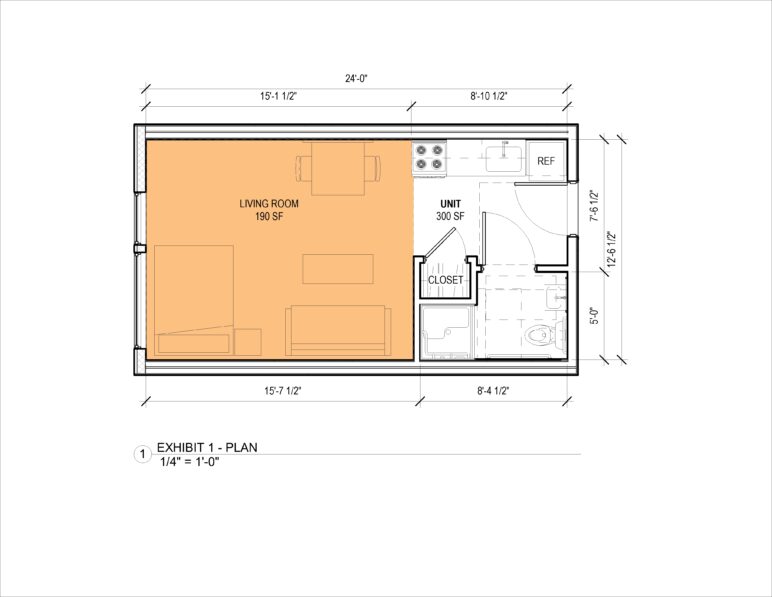
Figure 1: A mandated 190-square-foot living room in a 300-square-foot home reduces kitchen and storage spaces to their absolute minimums. Image by Neiman Taber Architects.
Status evolved: More livability, less living room
Now let’s try a different approach. From a livability perspective, empty floor space is probably the least important feature that a person needs in their home.
In this redesigned plan of the same unit, we’ve increased the kitchen size, providing more countertop workspace, additional storage and cabinets, a washer-dryer unit, a desk, and bookshelves. There’s still enough room for furniture, but by trading some living room area for more practical built-in features, we’ve created a significantly more comfortable home. And the total unit size is still 300 square feet.
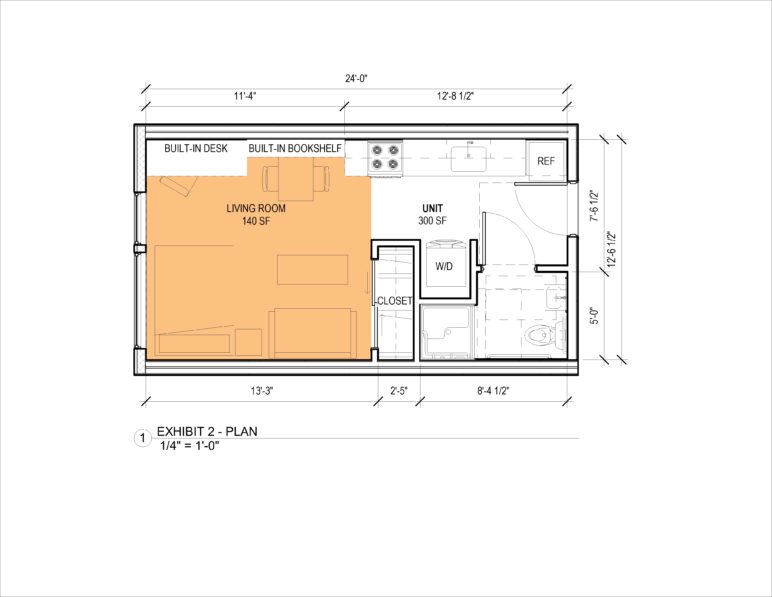
Figure 2: A revised design with a 140-square-foot living room in a 300-square-foot home increases kitchen counter space and adds more storage space, built-in furniture, and even a washer-dryer. Image by Neiman Taber Architects.
Use the slider below to compare the two designs: the first with its 190-square-foot living room and the second with its 140-square-foot living room—and added kitchen counter space, storage space, built-in furniture, and even a washer-dryer. Which would you prefer to live in?
These two plans demonstrate a simple point: If you’re trying to design a building code to make a small unit more livable, forcing the living room to be larger is the wrong approach. Unfortunately, this is exactly what the IBC does.
The origins of the IBC’s 190-square-foot living room mandate
It’s worth a moment to discuss where the requirement for a 190-square-foot living room comes from. It’s not a universally accepted number. Until the 2018 IBC code update, the minimum standard for a living room was 220 square feet. Seattle’s SEDU standards allow for a 120- to 150-square-foot living room, depending on how you measure it. The IBC also allows congregate housing units—i.e., where residents have a private bedroom but share things like a kitchen, dining room, and other common spaces—with living spaces as small as 70 square feet. These are all forms of permanent housing meant for use by the general public, yet the size requirements vary widely.
A skeptical observer might wonder if these square footage requirements have any empirical basis or are merely arbitrary. A review of historical codes would prove the skeptic right. The Uniform Building Code, the predecessor to the IBC we use today, was first published in 1927. About two decades later in 1946, it introduced minimum room sizes, including an 80-square-foot living room. In 1964 the requirement grew to 90 square feet. In 1973, the requirement suddenly more than doubled to 220 square feet.
The square footage minimums do not stem from a long tradition nor any particular health or safety principle. The fact that today’s standard arrived suddenly in the early 1970s likely has more to do with urban politics of the day. At that time, most American cities were in decline, losing their population and tax base to the suburbs and struggling with high crimes rates. In reaction, many cities enacted policies aimed at getting rid of small, low-cost housing types like SROs where poor people lived.
Another way: Public health-informed priorities and sizing
Public health experts have long acknowledged that the built environment heavily impacts human health. The National Healthy Housing Standard (NHHS), developed by public health professionals, serves as a tool for planners, elected officials, and policymakers to design regulations for housing that are based on the public health literature.2
So what does the NHHS standard recommend for minimum living room sizes? A mere 70 square feet. However, this is not the end of the story. While the IBC focuses primarily on living room size, the NHHS gives more attention to subjects such as cleanliness, adequate storage, and functional food preparation.
For example, the NHHS stipulates the need for a kitchen with both a range top and oven, a refrigerator and a freezer, and a designated space for utensils and cooking tools. It also requires a kitchen to have a washable backsplash and cleanable floors. In contrast, the IBC remains mostly silent on these matters, requiring only a microwave oven, a sink, and a mini-fridge.
Another example: The NHHS mandates the use of low-pile carpets, non-absorbent flooring, low-VOC finishes, and other requirements aimed at providing cleanable surfaces and healthy indoor air quality. The IBC is silent on these matters.
In general, if we look to the IBC as a guide for designing micro-homes, we end up with larger and more expensive housing units than necessary, often lacking important livability features. In contrast, the NHHS permits smaller and more efficient homes but demands other essential amenities for livability, well-being, and sanitation.
What would a better micro-home look like?
At this point we’ve established a few things.
- The current standards are somewhat arbitrary.
- Living room size is not a reliable measure of livability.
- A better standard would focus much less on unit size and more on design elements that support healthy lifestyles.
Clearly, we can build humane, quality housing smaller than what the IBC code allows today, but the question remains: how small is too small? Below are floor plans for micro-homes with living rooms of 120, 95, and 70 square feet in 250-, 220-, and 200-square foot units respectively—and plenty of space for living well in each.
The 120 in a 250: A Seattle SEDU-compliant option
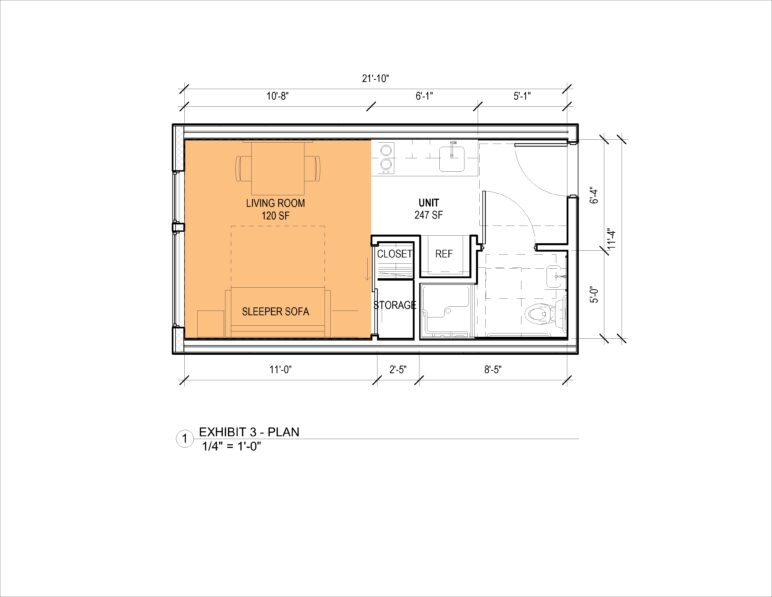
Figure 3: A 250-square-foot studio that is Seattle SEDU-compliant. With a 120-square-foot living room, it can’t accommodate both a bed and couch in the living space. Image by the Neiman Taber Architects.
We’ll begin with a small studio along the lines of what Seattle allows for a Small Efficiency Dwelling Unit (SEDU). It complies with all of Seattle’s regulations, including some of the city’s idiosyncratic rules about countertop areas, storage configuration, and how to measure the living room.
In total, this SEDU measures 250 square feet. At this scale there is room for a basic kitchen, bathroom, and storage area, plus the minimum required 120-square-foot living room. The living room area can comfortably fit a dining room table plus one more large piece of furniture. Unlike the larger 300-square-foot studio in Figures 1 and 2, we don’t have enough space for both a couch and a bed, so we opted for a convertible sofa that can serve both purposes.
The 90 in a 220: More kitchen and storage, plus a washer-dryer
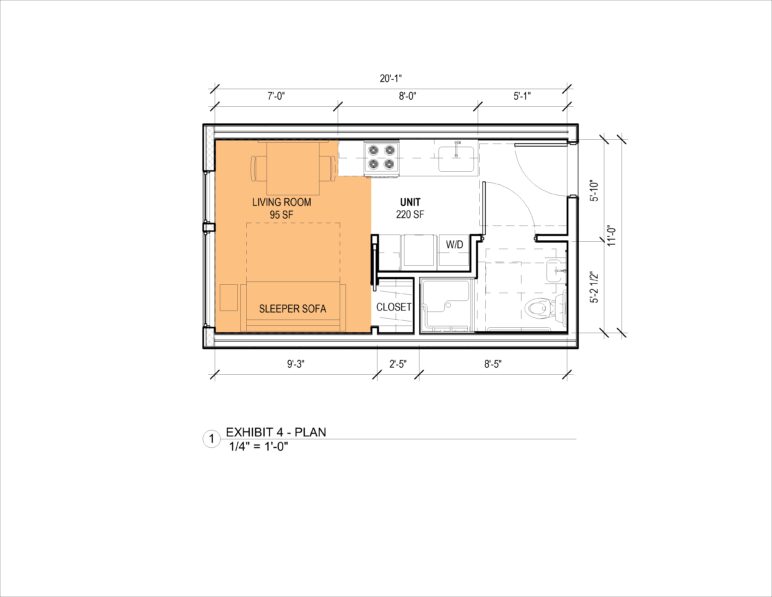
Figure 4: A 220-square-foot SEDU variation, with a smaller living room and more kitchen space, storage, and even a washer-dryer. It complies with Seattle’s SEDU rules for total square footage but not living room square footage. Image by Neiman Taber Architects.
This design is a variation on the SEDU. It meets the city’s minimum total square footage for a Seattle SEDU, but it dispenses with the city’s living room size minimum. (The design also meets the minimum requirement for a small studio under a similar program in San Francisco.)
This is the scale of unit that was typical for SEDUs in Seattle before 2016, when building officials enacted a series of code interpretations that changed the way that habitable space is measured, requiring a larger living room area. Compared to the slightly larger unit and living room above, here we can still fit the same suite of furniture, but also a larger kitchen, a more useful storage area, and a washer-dryer. For comparison, this living room is about 95 square feet, so losing just less than a quarter of the living room space of the prior design.
The 70 in a 200: NHHS-approved, with handy built-ins, more kitchen and storage, plus washer-dryer
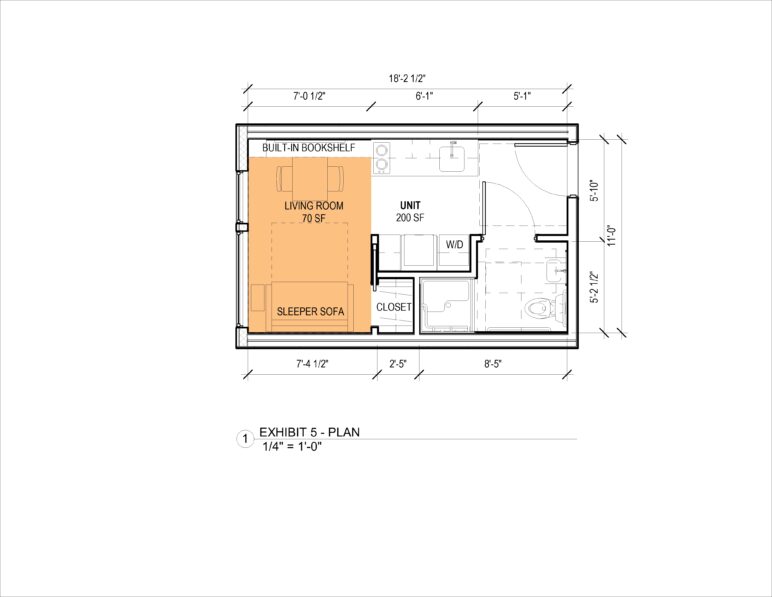
Figure 5: A 200-square-foot micro-home with a 70-square-foot living room boasts more kitchen and storage space, plus a handy built-in bookshelf, all compliant with the National Healthy Housing Standard. Image by Neiman Taber Architects.
The NHHS says that the minimum habitable space for a dwelling unit’s living room is 70 square feet. So let’s look at what that accomplishes in terms of the overall unit size and layout
We’ve kept a similar suite of amenities in the kitchen and bathroom as the prior design, meaning more kitchen countertop and storage, plus a washer-dryer. And with only 70 square feet of living room area, there’s still enough room for a sleeper sofa and dining table, plus we’ve increased the functional use of the room with a built-in bookshelf. It’s cozier than the versions with larger living rooms but still a functional home that serves a person’s basic needs well and comfortably. The overall size of this unit comes out to just over 200 square feet.
Policymakers should prioritize livability and an abundance of housing options
The IBC standards that we use today to regulate small unit housing are clearly counterproductive. They prohibit the creation of smaller, more affordable units that could help put a dent in our housing crisis, and they prioritize space over livability, functionality, and cleanliness.
If lawmakers have concerns about the livability of small units, they should look to the standards of the NHHS for guidance. Current living room requirements have no empirical basis; they make our housing less plentiful and more expensive; and contrary to their intent, they result in less functional housing units with fewer amenities. It’s possible to make desirable homes for people far smaller than the size required by the IBC. The options we illustrated work well down to about 200 square feet.
It’s possible to go even smaller. In our congregate housing projects, units can be as small as 120-150 square feet when the building also provides common kitchen, dining, and other amenities that supplement the private units. This illustrates a larger point, which is that beyond the basics, the specific features of the private unit are often less important than the quality of the environment in which they are situated.
Likewise, micro-homes work best in neighborhoods that provide residents with easy access to amenities such as parks, grocery stores, libraries, schools, restaurants, retail, and services.
Policymakers can unlock housing opportunities for thousands more people in Washington and across Cascadia by amending our state building code to reduce the minimum living room size, allowing builders throughout Washington to create plentiful, affordable homes for their communities.
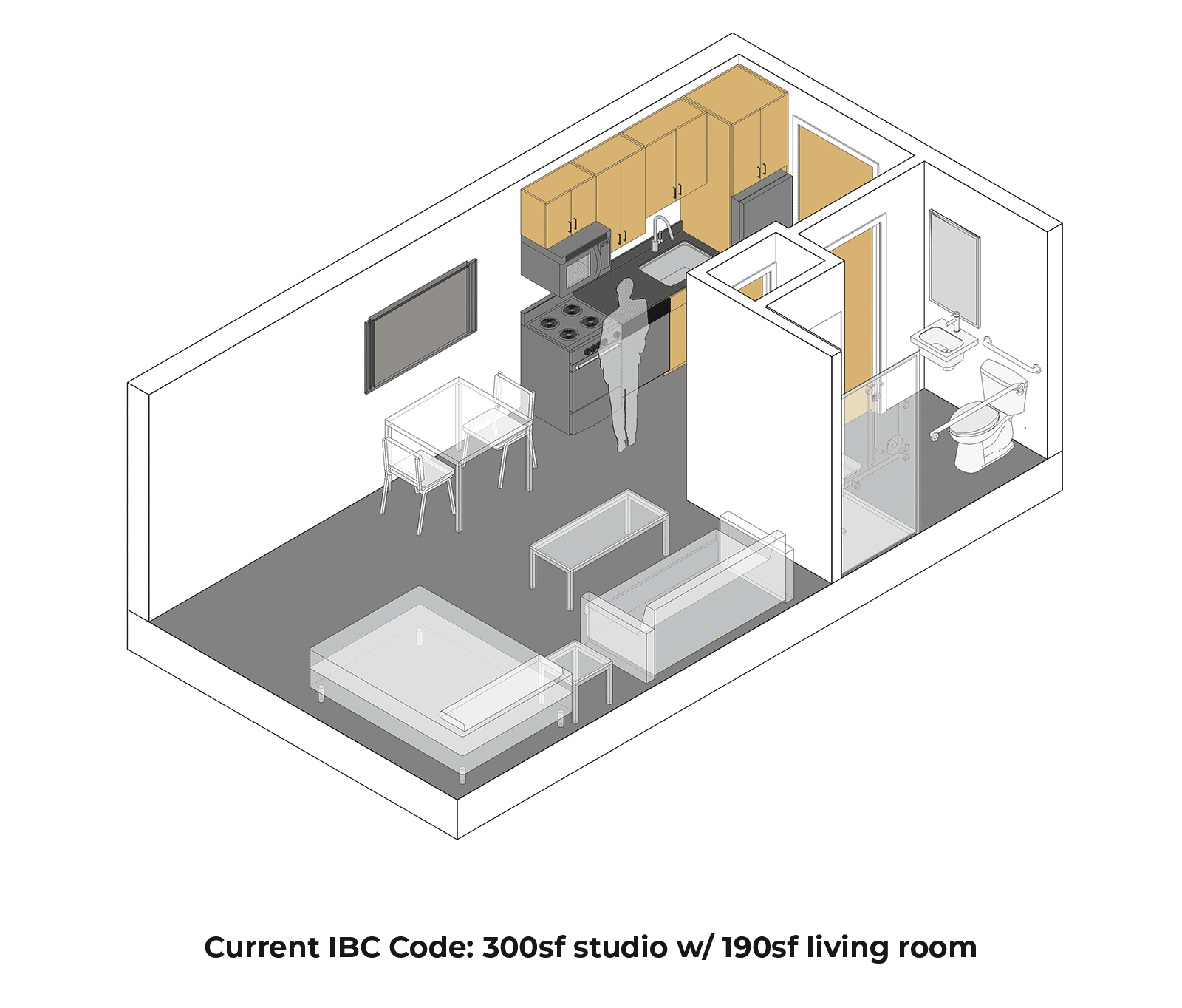
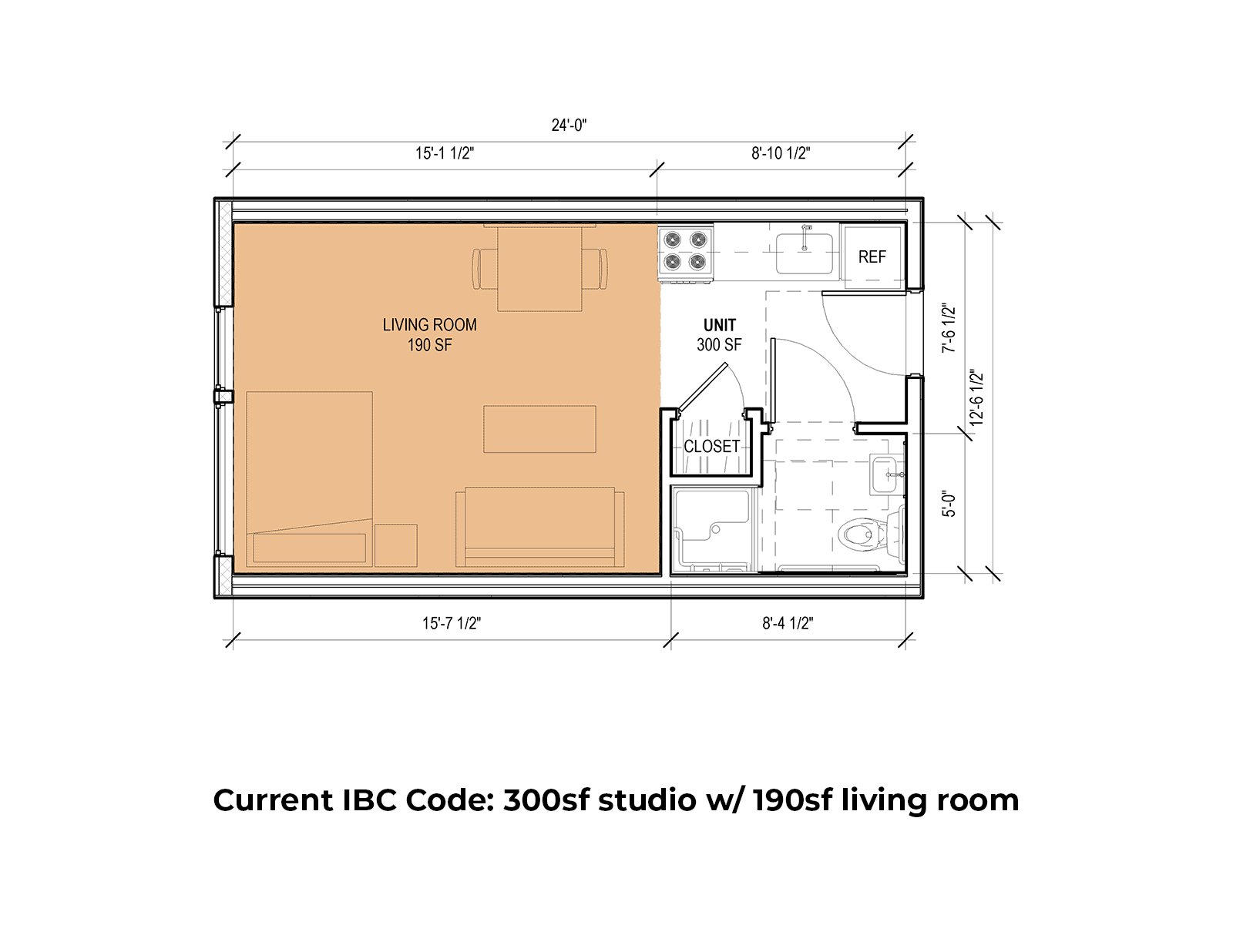

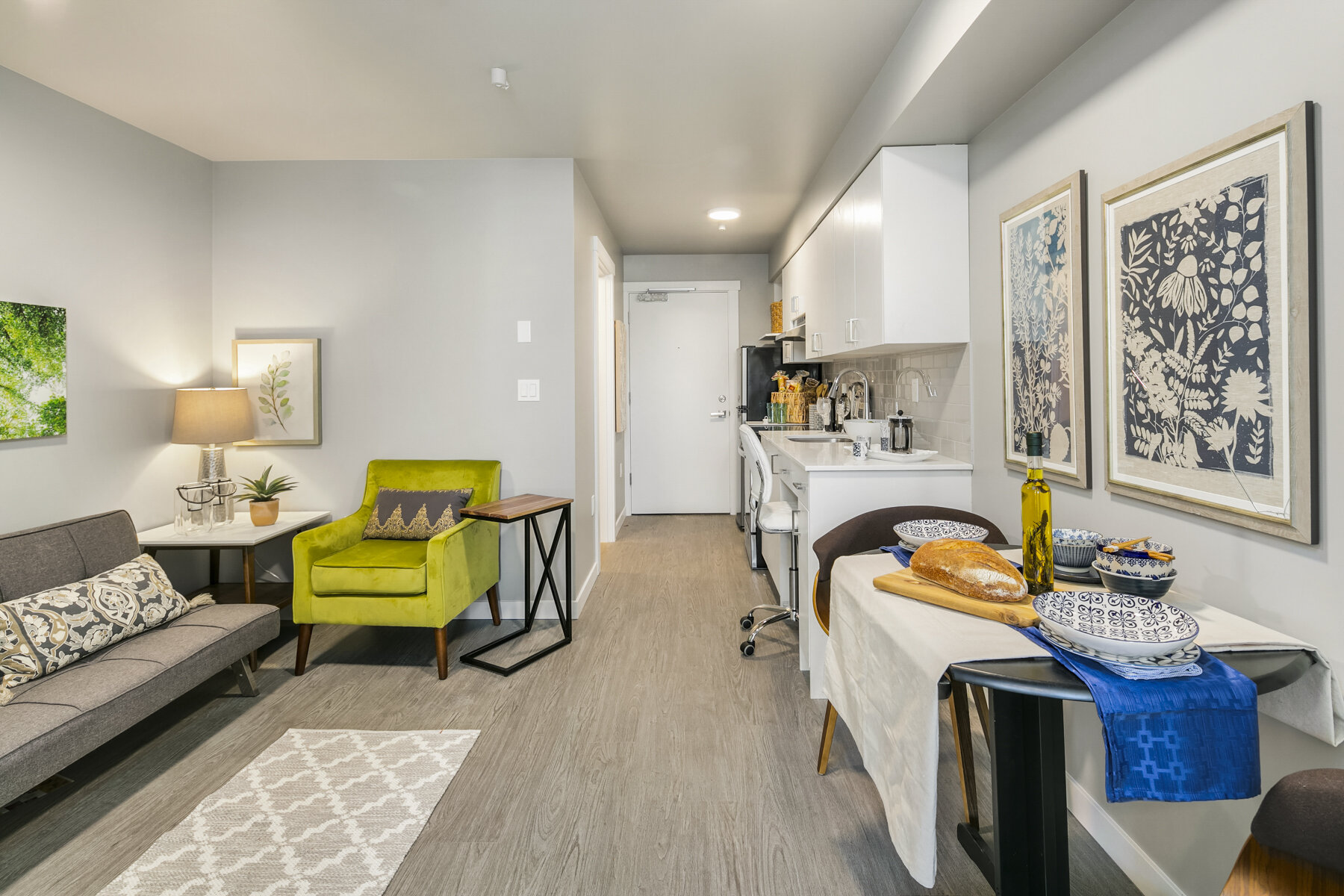
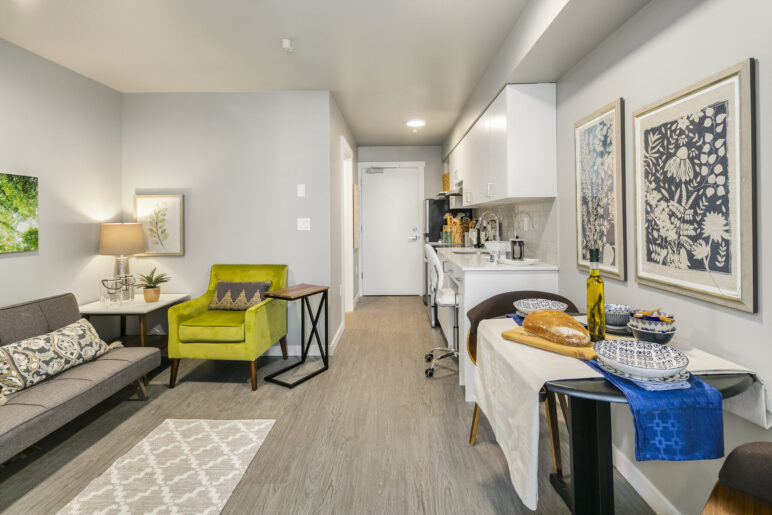







Marti
It seems like no one ever asks renters what size or amenities they want. I can honestly say if I’m going to be cooped up in a rainy Seattle area tiny rental it better have a separate bedroom that accommodates a queen size bed you can walk around, a dresser, a bedside table, and have a full size closet; and also should have a living room, dining space for three ( not a counter bar), galley or u shaped kitchen, full bathroom with bath/shower combo and a stacking washer/dryer. And storage space at least as deep as a second closet. And an included parking space tall enough and wide enough for an SUV. I’d say that’s gonna need to be about 350-400sq feet to keep from going crazy.
David Neiman
What you just described is a ~500sf 1-br apartment. I think you have fairly well summed up the wish list that the broad majority of renters are looking for. I think most conventional multi-family developers would agree that is more or less what their residents are looking for. The dilemma is this: In Seattle, that unit is going to rent for at least $2,000, and be affordable for some making about $85,000/year. Building smaller allows for the creation of homes that people of modest means can afford in neighborhoods they’d otherwise be priced out of. They are not for everybody, but they provide people homes in great neighborhoods with access to jobs, opportunity, culture, community, etc. It might not be your bag, but its exactly what some people need, and they deserve the option to choose for themselves.
N
Thanks for this, very interesting. Do the codes mention wet rooms in bathrooms? I’ve not seen them in the PNW, but they looked very functional in apartments in Denmark. The link below (included as a separate comment in case links aren’t ok) shows examples of what I’m thinking of. In city apartments in Copenhagen, this seemed like a good way to save bathroom space to allow for more living space, though the total space may need to be larger for wheelchair users and other aspects under ADA.
David Neiman
American construction codes don’t discourage the kind of “wet” bathroom that is common in Europe. But the minimum sizes and clearances that are dictated by the Fair Housing Act and the accessibility requirements of the IBC are really what drive the size of the bathroom and its overall design. The configurations you showed in the link are interesting designs but alas not necessarily compliant with the code requirements, which are quite prescriptive.
N
https://www.apartmenttherapy.com/wet-rooms-have-advantages-over-traditional-bathrooms-252456 Wet room example
Kit
I might have missed it, but I don’t see it mentioned about vertical space. That is a huge component of experiencing a space as ‘larger’ or more spacious. Although I realize that could require more construction cost as there is less plenum for infrastructure.
I loved this piece. Excellent, lucid descriptions and comparisons.
Paul
My daughter recently moved into an apartment in New York City that is about 100 sf. The living room/kitchen/dining room is about 8’x9′ and it has a bathroom that is about 3’x8′. The ‘kitchen’ has a small sink, 2 electric burners and undercounter fridge. She texted today that she successfully made a chicken pot pie in her toaster oven. Her ‘sleeper chair’ when open does block the entry door a bit, and it is certainly not accessible, but she seems happy for the time being. It wouldn’t work for everyone, but it does fill a need.
David Neiman
Small-units are not a solution for everyone. But for a lot of people, it is exactly the thing that they need.
Greg Francis
This sort of housing would also be very beneficial in markets like Spokane, where our median income is very low in comparison to our housing costs, which have risen dramatically over the past four years. We should have an objective of providing housing opportunities for all citizens even those at the lowest incomes. This is one way to help meet that objective without having to provide subsidies.
David Neiman
Its is our goal to pass legislation that will make it easier to build small apartments in cities throughout the state. I think Spokane residents would benefit greatly from having this type of housing as an option.
Diane Sugimura
Great research and analysis, David! As we have discussed in the past, at least in Seattle, I believe the regs do need to be updated! The IBC … have you worked with the Seattle technical code folks? Are they supportive of IBC changes? In years past Seattle staff were pretty successful at getting changes made at the state and national level, although it may take a couple code cycles. Perhaps state legislature can help … they made amazing housing changes last year! Thanks
David Neiman
Within Seattle, the Construction Code Advisory Board has been the primary obstacle. This is a volunteer board which advises SDCI on Seattle code amendments and directors rules. One of my interactions with them is pretty well documented here: https://www.sightline.org/2017/03/20/how-seattle-killed-micro-housing-again/
My hope is that we can get the legislature to ask for changes to the WSBC that would enable small-unit housing throughout the state as a baseline in all cities.
Val
Thank you for a very informative article. It has always seemed odd that building codes try to dictate how people live. I understand the life & safety requirements but saying your living room must be a certain size makes no sense. Its not a functional room like a kitchen or bath. Its like certain ADU requirements. Most people I design for are building them for family members and don’t understand the often prohibitively expensive requirements of separate electrical panels, etc. If the unit was going to be rented I understand but for most its just for family members.
Cquinn
I think there should be a separation between living room and bedroom, a partition wall could work. You assume poor people love showers, they don’t. Baths are important. The Pullman kitchen (with all appliances and sink on one long wall) is not a good way to cook. Create a floor plan that allows for a shape other than a box/rectangle, so that each apt can have a nook, maybe a kitchenette, with fridge, sink, stove not against one wall. This non-box design may allow for more windows. A person should be able to choose where they want to put a desk, book shelves, bed, couch, table, so do not do a bunch of built in spaces which make it impossible to move the furniture for a unique individuals need. And I emplore you, do not put the kitchen next to the bathroom. Do any of you architects cook?
David Neiman
Actually, almost every architect I know likes to cook. The two skill sets have a lot in common, combining technical knowledge with artistry, canonical adherence with improvisation, and a thirst for innovation grounded by the limitations of what our senses tell us is desirable to see, smell, and taste.
As for the rest, we are going to have to agree to disagree.
H. Pike Oliver
Thanks for this article about your ongoing work on this important topic. I will include a reference to it in the next issue of the monthly ARES Urbanexus Update — https://news.ares.org.
Derek Blackwell
What an insulting and dehumanizing title and article. You can’t tell us the rise in crime, mental health issues, suicide, domestic violence and road rage has nothing to do with this devaluation of human life. Lack of opportunities for young people and dwindling resources for seniors continue to exacerbate this very sad situation. Oh yes, and are these structures adequately soundproofed? When you can hear your neighbor going to the bathroom that’s inadequate privacy.
If this is what survival has come to let’s not lose sight of the fact that we deserve better. What’s presented here paints the developers as the victims. Many of us will be dead by the time a halfway adequate train system is completed. Priorities are so skewed in favor of private interests people don’t even notice, they are so beaten down and exhausted from overwork.
I live in Shoreline where trees are being felled in reckless abandon. I shared with an environmental attorney that the city plans to double it’s population (and heat islands). The immediate reply – “Money money money!”.
DAVID
Very well done article! Clear, precise and great graphics. I have shared this will others in the affordable housing industry of Spokane that I am currently working with.
David Moore
Cities get expensive and all alternatives are important to examine. Smaller and taller will house more people than want or really need to live close into the central city. codes requiring luxury force out the poor.
Shylee
I think a key aspect missing here is that this is not how everyone wants to live and the fact that micro-studios are offering 100 sqft. with no closet, no stovetop burner, and the only option to put your bed in your kitchen for 1,400+ a month is absurd. By adding more of these units and making them more “affordable”… say 1,100 a month, that only inflates the market for people that can’t mentally function in a space like this. Thus, making 300-400 sqft. studios 2,000+ a month instead of 1,600. The issue to be solved here isn’t that we need more badly constructed micro-studios. It’s that we need landlords to lower their rents and a lot of that comes from lower taxes to homeowners and repercussions to vacant units.
It’s also not addressing that the segregation that will come from this will be outrageous. If these micro-studios become the only option for people that make less than 60,000/70,000 a year then you’re basically just putting us in the back of the train in Snowpiercer. These aren’t affordable. And they aren’t the better option to “living” that everyone with money seems to think they are.